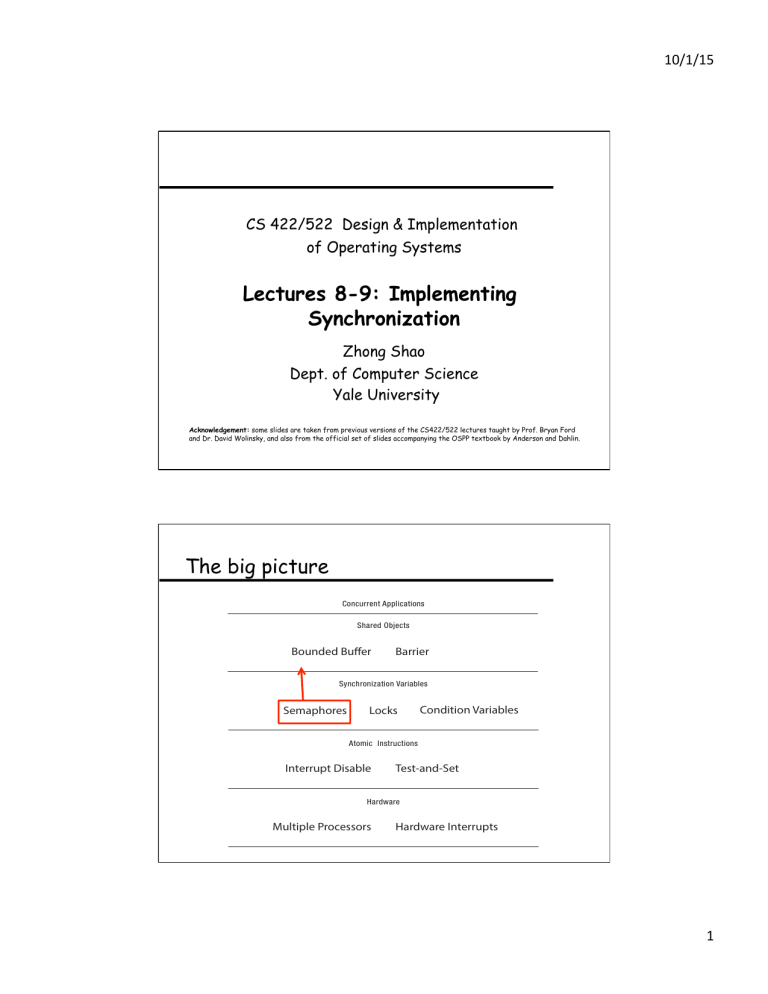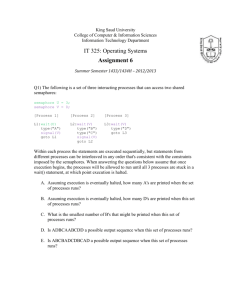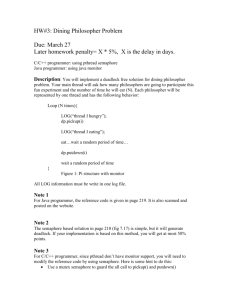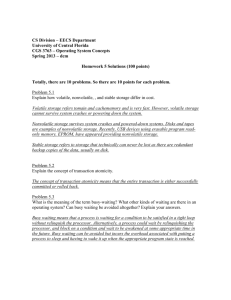Document 10733339

10/1/15
CS 422/522 Design & Implementation of Operating Systems
Lectures 8-9: Implementing
Synchronization
Zhong Shao
Dept. of Computer Science
Yale University
Acknowledgement: some slides are taken from previous versions of the CS422/522 lectures taught by Prof. Bryan Ford and Dr. David Wolinsky, and also from the official set of slides accompanying the OSPP textbook by Anderson and Dahlin.
The big picture
Concurrent Applications
Shared Objects
Bounded Bu ff er Barrier
Synchronization Variables
Semaphores Locks Condition Variables
Atomic Instructions
Interrupt Disable Test-and-Set
Hardware
Multiple Processors Hardware Interrupts
1
Semaphores
(Dijkstra 1965)
◆
◆
Semaphores are a kind of generalized lock.
*
They are the main synchronization primitives used in the earlier Unix.
Semaphores have a non-negative integer value, and support two operations:
–
semaphore->P(): an atomic operation that waits for semaphore to become positive, then decrements it by 1
–
semaphore->V(): an atomic operation that increments semaphore by 1, waking up a waiting P, if any.
◆
Semaphores are like integers except:
(1) none-negative values; (2) only allow P&V --- can’t read/write value except to set it initially; (3) operations must be atomic: two P’s that occur together can’t decrement the value below zero. Similarly, thread going to sleep in P won’t miss wakeup from V, even if they both happen at about the same time.
Implementing semaphores
P means “test” (proberen in Dutch)
V means “increment” (verhogen in Dutch) class Semaphore { int value = initialValue; }
Semaphore::P() {
Disable interrupts;
while (value == 0) {
Put on queue of threads waiting
for this semaphore;
Go to sleep;
}
value = value - 1;
Enable interrupts
}
Semaphore::V() {
Disable interrupts ;
if anyone on wait queue {
Take a waiting thread off wait
queue and put it on the ready
queue;
}
value = value + 1;
Enable interrupts
}
10/1/15
2
Binary semaphores
Like a lock; also known as “mutex”; can only have value 0 or 1 (unlike the previous “counting semaphore” which can be any non-negative integers) class Semaphore { int value = 0 or 1; }
Semaphore::P() {
Disable interrupts;
while (value == 0) {
Put on queue of threads waiting
for this semaphore;
Go to sleep;
}
value = 0;
Enable interrupts
}
Semaphore::V() {
Disable interrupts ;
if anyone on wait queue {
Take a waiting thread off wait
queue and put it on the ready
queue;
}
value = 1;
Enable interrupts
}
How to use semaphores
◆
◆
Binary semaphores can be used for mutual exclusion: initial value of 1; P() is called before the critical section; and V() is called after the critical section.
semaphore->P();
// critical section goes here
semaphore->V();
Scheduling constraints
–
having one thread to wait for something to happen
*
Example: Thread::Join, which must wait for a thread to terminate. By setting the initial value to 0 instead of 1, we can implement waiting on a semaphore
◆
Controlling access to a finite resource
10/1/15
3
Scheduling constaints
◆
Something must happen after one another
Initial value of semaphore = 0;
Fork a child thread
Thread::Join calls P // will wait until something
// makes the semaphore positive
-------------------------------------------------------------------------
Thread finish calls V // makes the semaphore positive
// and wakes up the thread
// waiting in Join
Scheduling with semaphores
◆
◆
In general, scheduling dependencies between threads T
T
2
, …, T n
can be enforced with n-1 semaphores, S
1
, S
2
, …,
,
S
–
n-1
T
–
T
used as follows:
1
runs and signals V(S
1
) when done. m
waits on S m-1
(using P) and signals V(S m
) when done.
1
(contrived) example: schedule print(f(x,y)) float x, y, z; sem Sx = 0, Sy = 0, Sz = 0;
T1: T2: T3:
x = …; P(Sx);
V(Sx);
P(Sz);
print(z);
y = …; z = f(x,y); …
V(Sy);
P(Sy);
V(Sz);
… ...
10/1/15
4
Producer-consumer with semaphores (1)
◆
Correctness constraints
*
consumer must wait for producer to fill buffers, if all empty (scheduling constraints)
*
producer must wait for consumer to empty buffers, if all full (scheduling constaints)
*
Only one thread can manipulate buffer queue at a time (mutual exclusion)
◆
General rule of thumb: use a separate semaphore for each constraint
Semaphore fullBuffers; // consumer’s constraint
// if 0, no coke in machine
Semaphore emptyBuffers; // producer’s constraint
// if 0, nowhere to put more coke
Semaphore mutex; // mutual exclusion
Producer-consumer with semaphores (2)
Semaphore fullBuffers = 0; // initially no coke
Semaphore emptyBuffers = numBuffers;
// initially, # of empty slots semaphore used to
// count how many resources there are
Semaphore mutex = 1; // no one using the machine
Producer() {
emptyBuffers.P(); // check if there is space
// for more coke
mutex.P(); // make sure no one else
// is using machine
put 1 Coke in machine;
mutex.V(); // ok for others to use machine
fullBuffers.V(); // tell consumers there is now
// a Coke in the machine
}
Consumer() {
fullBuffers.P(); // check if there is
// a coke in the machine
mutex.P(); // make sure no one
// else is using machine
take 1 Coke out;
mutex.V(); // next person’s turn
emptyBuffers.V(); // tell producer
// we need more
}
What if we have 2 producers and
2 consumers?
10/1/15
5
Order of P&Vs --- what can go wrong
Semaphore fullBuffers = 0; // initially no coke
Semaphore emptyBuffers = numBuffers;
// initially, # of empty slots semaphore used to
// count how many resources there are
Semaphore mutex = 1; // no one using the machine
Producer() { mutex.P(); // make sure no one else
// is using machine
emptyBuffers.P(); // check if there is space
// for more coke
put 1 Coke in machine;
fullBuffers.V(); // tell consumers there is now
// a Coke in the machine mutex.V(); // ok for others to use machine
}
Consumer() { mutex.P(); // make sure no one
// else is using machine fullBuffers.P(); // check if there is
// a coke in the machine
take 1 Coke out;
emptyBuffers.V(); // tell producer
// we need more mutex.V(); // next person’s turn
}
Deadlock ---two or more processes are waiting indefinitely for an event that can be caused by only one of the waiting processes.
Implementing synchronization
Concurrent Applications
Shared Objects
Bounded Bu ff er Barrier
Synchronization Variables
Semaphores Locks Condition Variables
Atomic Instructions
Interrupt Disable Test-and-Set
Hardware
Multiple Processors Hardware Interrupts
10/1/15
6
Implementing synchronization
Take 1: using memory load/store
–
See too much milk solution/Peterson’s algorithm
Take 2:
Lock::acquire()
{ disable interrupts }
Lock::release()
{ enable interrupts }
Take 3: queueing locks
No point on running the threads waiting for locks
Lock implementation, uniprocessor
Lock:: acquire () {
disableInterrupts();
if (value == BUSY) {
waiting.add(myTCB);
myTCB->state = WAITING;
next = readyList.remove(); switch (myTCB, next);
myTCB->state = RUNNING;
} else {
value = BUSY;
}
enableInterrupts();
} class Lock {
private int value = FREE;
private Queue waiting ;
public void acquire();
public void release();
}
Lock:: release () {
disableInterrupts();
if (!waiting.Empty()) {
next = waiting.remove();
next->state = READY;
readyList.add(next);
} else {
value = FREE;
}
enableInterrupts();
}
10/1/15
7
Multiprocessor
◆
◆
◆
Read-modify-write instructions
–
Atomically read a value from memory, operate on it, and then write it back to memory
–
Intervening instructions prevented in hardware
Examples
–
Test and set
–
Intel: xchgb, lock prefix
–
Compare and swap
Any of these can be used for implementing locks and condition variables!
Spinlocks
A spinlock is a lock where the processor waits in a loop for the lock to become free
–
Assumes lock will be held for a short time
–
Used to protect the CPU scheduler and to implement locks
Spinlock::acquire () {
while (testAndSet(&lockValue) == BUSY)
;
}
Spinlock::release () {
lockValue = FREE;
memorybarrier();
}
10/1/15
8
How many spinlocks?
◆
Various data structures
–
Queue of waiting threads on lock X
–
Queue of waiting threads on lock Y
–
List of threads ready to run
◆
One spinlock per kernel?
–
Bottleneck!
◆
Instead:
–
One spinlock per lock
–
One spinlock for the scheduler ready list
*
Per-core ready list: one spinlock per core
What thread is currently running?
◆
◆
◆
Thread scheduler needs to find the TCB of the currently running thread
–
To suspend and switch to a new thread
–
To check if the current thread holds a lock before acquiring or releasing it
On a uniprocessor, easy: just use a global
On a multiprocessor, various methods:
–
Compiler dedicates a register (e.g., r31 points to TCB running on the this CPU; each CPU has its own r31)
–
If hardware has a special per-processor register, use it
–
Fixed-size stacks: put a pointer to the TCB at the bottom of its stack
*
Find it by masking the current stack pointer
10/1/15
9
10/1/15
Lock implementation, multiprocessor
class Lock {
private int value = FREE;
private SpinLock spinLock ;
private Queue waiting ; …}
Lock::acquire() {
disableInterrupts();
spinLock.acquire();
if (value == BUSY) {
waiting.add(myTCB); scheduler->suspend(&spinlock);
} else {
value = BUSY;
spinLock.release();
}
enableInterrupts();
}
Lock::release() {
disableInterrupts();
spinLock.acquire();
if (!waiting.Empty()) {
next = waiting.remove(); scheduler->makeReady(next);
} else {
value = FREE;
}
spinLock.release();
enableInterrupts();
}
Lock implementation, multiprocessor (cont’d)
class Scheduler {
private:
Queue readyList;
SpinLock schedulerSpinLock;
public:
void suspend(SpinLock *lock);
void makeReady(Thread *thread);
} void
Scheduler:: makeReady (TCB *thread) {
disableInterrupts();
schedulerSpinLock.acquire();
readyList.add(thread);
thread->state = READY;
schedulerSpinLock.release();
enableInterrupts();
} void
Scheduler:: suspend (SpinLock *lock) {
TCB *chosenTCB;
disableInterrupts();
schedulerSpinLock.acquire();
lock->release();
runningThread->state = WAITING;
chosenTCB = readyList.getNextThread();
thread_switch(runningThread, chosenTCB);
runningThread->state = RUNNING;
schedulerSpinLock.release();
enableInterrupts();
}
10
Condition variable implementation, multiprocessor
class CV {
private Queue waiting;
public void wait(Lock *lock);
public void signal();
public void broadcast();
}
// Monitor lock held by current thread. void CV:: wait (Lock *lock) {
assert(lock.isHeld());
waiting.add(myTCB);
// Switch to new thread & release lock.
scheduler.
suspend (&lock);
lock->acquire();
}
// Monitor lock held by current thread. void CV:: signal () {
if (waiting.notEmpty()) {
thread = waiting.remove();
scheduler.
makeReady (thread);
}
} void CV:: broadcast () {
while (waiting.notEmpty()) {
thread = waiting.remove();
scheduler.
makeReady (thread);
}
}
Semaphore implementation, a comparison
Semaphore::V() {
disableInterrupts();
spinLock.acquire();
if (!waiting.Empty()) {
next = waiting.remove();
scheduler->makeReady(next);
} else {
value++;
}
spinLock.release();
enableInterrupts();
}
Semaphore::P() {
disableInterrupts();
spinLock.acquire();
if (value == 0) {
waiting.add(myTCB);
suspend(&spinlock);
} else {
value--;
}
spinLock.release();
enableInterrupts();
}
10/1/15
11
“Semaphores considered harmful!”
◆
Using separate lock and condition variable classes makes code more self-documenting and easier to read
–
The code is clearer when the role of each synchronization variable is made clear through explicit typing
◆
A stateless condition variable bound to a lock is a better abstraction for generalized waiting than a semaphore
–
Semaphores rely on the programmer to carefully mapthe object’s state to the semaphore’s value …
◆
Nevertheless, semaphores are used for synchronizing communication between an I/O device and threads waiting for I/O completion.
Implementing Condition Variables using
Semaphores (Take 1)
wait(lock) {
lock.release();
semaphore.P();
lock.acquire();
} signal() {
semaphore.V();
}
10/1/15
12
Implementing Condition Variables using Semaphores (Take 2)
wait(lock) {
lock.release();
semaphore.P();
lock.acquire();
} signal() {
if (semaphore queue is not empty)
semaphore.V();
}
Implementing Condition Variables using Semaphores (Take 3)
wait(lock) {
semaphore = new Semaphore;
queue.Append(semaphore); // queue of waiting threads
lock.release();
semaphore.P();
lock.acquire();
} signal() {
if (!queue.Empty()) {
semaphore = queue.Remove();
semaphore.V(); // wake up waiter
}
}
10/1/15
13
Lock implementation, Linux
◆
◆
◆
Most locks are free most of the time
–
Why?
–
Linux implementation takes advantage of this fact
Fast path
–
If lock is FREE, and no one is waiting, two instructions to acquire the lock
–
If no one is waiting, two instructions to release the lock
Slow path
–
If lock is BUSY or someone is waiting, use multiproc impl.
◆
User-level locks
–
Fast path: acquire lock using test&set
–
Slow path: system call to kernel, use kernel lock
Lock implementation, Linux
struct mutex {
/ ∗ 1 : unlocked ;
0 : locked; negative : locked,
possible waiters ∗ /
atomic_t count ;
spinlock_t wait_lock ;
struct list_head wait_list ;
};
// atomic decrement
// %eax is pointer to count lock decl (%eax) jns 1f // jump if not signed
// (if value is now 0) call slowpath_acquire
1:
10/1/15
14
Communicating Sequential Processes
(CSP/Google Go)
◆
A thread per shared object
–
Only thread allowed to touch object’s data
–
To call a method on the object, send thread a message with method name, arguments
–
Thread waits in a loop, get msg, do operation
◆
No memory races!
10/1/15
Example: Bounded Buffer
get() {
lock.acquire();
while (front == tail) {
empty.wait(lock);
}
item = buf[front % MAX];
front++;
full.signal(lock);
lock.release();
return item;
} put(item) {
lock.acquire();
while ((tail – front) == MAX) {
full.wait(lock);
}
buf[tail % MAX] = item;
tail++;
empty.signal(lock);
lock.release();
}
Initially: front = tail = 0; MAX is buffer capacity empty/full are condition variables
15
Bounded Buffer (CSP)
while (cmd = getNext()) {
if (cmd == GET) {
if (front < tail) {
// do get
// send reply
// if pending put, do it
// and send reply
} else
// queue get operation
}
}
else { // cmd == PUT
if ((tail – front) < MAX) {
// do put
// send reply
// if pending get, do it
// and send reply
} else
// queue put operation
Locks/CVs vs. CSP
◆
◆
◆
◆
Create a lock on shared data
= create a single thread to operate on data
Call a method on a shared object
= send a message/wait for reply
Wait for a condition
= queue an operation that can’t be completed just yet
Signal a condition
= perform a queued operation, now enabled
10/1/15
16
Remember the rules
◆
◆
◆
◆
◆
◆
Use consistent structure
Always use locks and condition variables
Always acquire lock at beginning of procedure, release at end
Always hold lock when using a condition variable
Always wait in while loop
Never spin in sleep()
10/1/15
17






